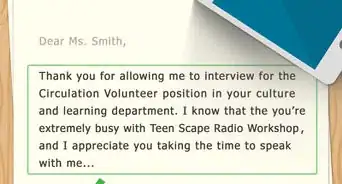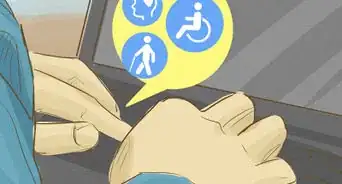This article was co-authored by wikiHow Staff. Our trained team of editors and researchers validate articles for accuracy and comprehensiveness. wikiHow's Content Management Team carefully monitors the work from our editorial staff to ensure that each article is backed by trusted research and meets our high quality standards.
There are 12 references cited in this article, which can be found at the bottom of the page.
wikiHow marks an article as reader-approved once it receives enough positive feedback. This article received 13 testimonials and 91% of readers who voted found it helpful, earning it our reader-approved status.
This article has been viewed 109,210 times.
Learn more...
The Red Cross is a charitable organization that provides humanitarian aid to people and regions that are in need. It offers relief to victims of disaster and helps communities to prevent, prepare for, and respond to emergencies. The easiest way you can be a part of its mission by volunteering. Red Cross volunteers are able to directly serve their community, which is rewarding, and are able to choose from many different ways to help. Figure out what time and talents you have to offer, train with your local office, and buckle down at your work, and you’ll be a valuable part of a great cause with a rich history.
Steps
Researching Ways to Help
-
1Learn about the mission of the Red Cross. Before you join the Red Cross as a volunteer, make sure you understand the organization and the people it serves. The Red Cross was founded over a century ago to alleviate human suffering in times of disaster and danger. Though the organization is known for helping in times of crisis, it also supports local communities all over the world in the day-to-day.[1]
-
2Evaluate the time commitment you can make. Working for the Red Cross is noble, and the efforts of volunteers are crucial. However, there are only so many hours in the week, and you probably have other things to worry about, like work, school, or family obligations. Be honest with yourself about the amount of time you have to dedicate to the Red Cross, and where it will fit into your schedule--whether that’s for a couple of hours a week, an entire day once a month, or as-needed for disaster relief.
- It might help you to take your paper or electronic calendar and mark the free time you have during the week.
Advertisement -
3Figure out what you want to do. The Red Cross is a behemoth of an organization, and many types of volunteers are needed to keep it running smoothly. This is great for you: it means there’s probably a position that suits your passions and talents. There are over 30 types of opportunities, depending on location. Here are some of the most common.[2]
- If you are good at administrative work, choose a clerical function. You can assist with mailings, grants, and special events.
- Investigate a stint on the Board of Directors if you have good leadership and fundraising skills.
- If you like to teach, volunteer as an instructor. The Red Cross uses volunteers to teach babysitting, life guarding, first aid, health, and water safety.
- If you want to volunteer in the field, sign up as a disaster prevention or response volunteer. You will have the opportunity to assist communities as they prepare for, prevent, and respond to disasters, but you may have to travel.
- Work as a volunteer on special services provided by the Red Cross. If you are especially interested in HIV/AIDS prevention, blood drives, homeless issues and humanitarian work, focus on that. Choose a project, and get involved in education, training, and other services.
- If you are eager to travel, and have foreign language skills and a large chunk of free time in your future, you can look into international volunteering opportunities.
-
4Call your local Red Cross. Find the number on your country’s national Red Cross website; for instance, here is the chapter listing for the US Red Cross. Each local chapter is different, depending on the needs of the community. It stands to reason that you will best learn exactly what you can do to help by talking to the chapter itself. The chapter should be able to connect you to a volunteer coordinator, whose job it is to make sure you’re informed. Ask plenty of questions.
- ”What kind of time commitment do you ask?” You should know how often you should come in every month, and for how long they seek to retain volunteers.
- ”Is there an area in which you’re looking for volunteers right now?” You might want to be a swim instructor, but don’t set your heart on it. If your chapter is glutted with swim instructors and is looking for someone to pass out snacks at blood drives instead, it’s best to go where you’re needed.
- ”Is any special certification required?” Most Red Crosses will provide the training you need to volunteer, but if you’re already, say, CPR-certified, you’ll be ahead of the game.
-
5Use Volunteer Match to find an opportunity. Once you’ve got an idea what it’s like to serve your local Red Cross, and you understand where you’re most needed, then sign up! Many countries’ Red Cross websites have a tool to match you up with appropriate volunteer opportunities. It should be easily accessible from the national website.
- Enter your location and field of interest.
- Include a few special skills that you have.
- Note the distance you are willing to travel.
- Mention whether you are open to working with kids, teens, seniors, or large groups.
- Be willing to wait a week or two for processing.
-
6Be open to a background check. Especially if you are volunteering with kids, the Red Cross may ask if they can run a background check on you. This is commonplace for volunteer positions of all kinds, so don’t be offended if you’re asked to complete one.[3] It’s really just to ensure that everyone the Red Cross serves (including you!) is safe.
Completing Your Training
-
1Review your existing skills. If you’re volunteering in a field that’s already a specialty of yours, you may want to refresh yourself so you’re in top shape to serve the organization. So do a review! Practice swimming or first aid, or review old textbooks to make sure you know the basics of your subject.
-
2Take an online orientation. In some cases, before you do in-person training, you can study up on your chosen volunteer post with a course on the Red Cross’s website. After you receive your volunteer placement, Google it to see if the Red Cross offers any resources online.
- Make sure you understand everything you learned in the orientation--if it helps, you can quiz yourself with the "knowledge check" at the end of certain sections.
- Review any area that you are unsure about.
- Bookmark the orientation when you’re finished. It might be helpful later.
-
3Train in-person. Your local chapter will let you know what kind of learning opportunities are required, and which are optional but accessible. Most offices will be able to train you in first aid and local disaster relief, which entails responses to things like house fires and accidents.[6]
- You may also have the option to get trained in national disaster relief, which involves larger-scale events like hurricanes and floods.
- For in-person training, be professional: arrive promptly, pay attention, and stay the whole time.
- Think about other training you’re interested in doing, even if they don’t directly pertain to your post. A well-rounded volunteer is a good volunteer.
-
4Get help when you need it. Never be afraid to get in touch with the volunteer coordinator. After all, it’s their job to make sure that all volunteers are equipped to serve the Red Cross to the best of their ability.[7] Reach out to them if you have questions about your duties, schedule, or the structure of the organization. They’re there to help.
- If you need to cancel a shift, let the coordinator know by calling as soon as possible and saying something like "Hi, it's Ruby, I won't be able to make my normal swimming class on Tuesday due to illness. Please let me know if I can help with finding a sub."
- If you're feeling a little overwhelmed and want to know ways to be more effective, you can say "I've appreciated the First Aid trainings I've done with the Red Cross, but I want to learn more about how to stay mentally calm and collected during an emergency. Do you know of any books or courses that might help?"
Serving the Red Cross
-
1Treat volunteering like a job. As a volunteer for the Red Cross, you’re doing some of the most important work in the world. It’s incredibly important to approach your commitment to the organization as seriously as you would approach a paying position. (Perhaps even more seriously--people’s lives are at stake!) This means sticking to professional and courteous behavior. Take steps to make sure you:
- Arrive on time and stay for your full shift.
- Honor your commitments. If you say you’re going to do something, then make sure you show up and do it.
- Do the best work you can. You can’t phone it in here--bring all the energy you can.
- Be kind and build relationships. Help out staff and fellow volunteers when you can, because it’s nice. In addition, you may want to ask for a reference in the future.[8]
-
2Be flexible. The Red Cross is needed because disaster can strike at any time or place.[9] As a volunteer for the Red Cross, you need to be ready for this. Plan ahead so you’re ready to help whenever the moment calls for it.
- Keep a charged cell phone with you for alerts.
- Trade phone numbers with fellow volunteers. You may need to call them for backup, or to fill in if you’re sick and have to miss a shift.
- Pack a backpack you can grab with supplies that you’ll need. This may include clean water, a radio, and medications.
-
3Keep learning. You may have finished your initial training, but there’s so much more to discover! Keep reading up on the organization’s history and your particular function within it. Remember to review and advance your existing certifications when necessary.
- If you’re working with a more experienced volunteer, ask questions.
- Broaden your horizons by taking additional non-required training. You might even discover a whole new area you want to volunteer in.
- Stay aware of current events. It's important to know about natural disasters that threaten other parts of the world, as well as your community.
-
4Support your fellow volunteers. Red Cross volunteers are some of the kindest and most dedicated people around. Though not everyone you meet will be your new best friend, it’s still worth your time to get to know the people you’re working alongside. You can teach each other a lot, and you’ll probably have a lot more fun on your shifts if you know your cohort.[10]
- On your shifts, ask your fellow volunteers (non-invasive) questions about their lives. What motivated them to start volunteering?
- Hold a skill share. If you work with several other volunteers, get together and learn! You can show each other cool skills that have to do with the Red Cross, or focus on other ones.
- Socialize outside of work. Go bowling or organize a potluck--anything that the group will enjoy.
-
5Help the Red Cross in other ways. The volunteers are the heart of the Red Cross, but it has other needs as well. In addition to volunteering, you can sign up to give blood, or make a donation to the charity.[11]
- For your birthday or the holidays, ask for donations to the organization in lieu of gifts.[12]
- Involve your friends and family, too. You might recruit new volunteers among them.
-
6Be proud of your work. The Red Cross is an organization with a long and wonderful history. It has accomplished amazing feats over the course of its existence, and a lot of this is directly due to the efforts of volunteers like you. Keep doing what you’re doing--you are becoming a small part of history.
Community Q&A
-
QuestionHow do I locate the nearest Red Cross center to volunteer?
 Community AnswerYour country's Red Cross page should have a locator on its website. Here is the American version: http://www.redcross.org/find-your-local-chapter
Community AnswerYour country's Red Cross page should have a locator on its website. Here is the American version: http://www.redcross.org/find-your-local-chapter -
QuestionHow do I get a certificate after volunteering?
 Community AnswerYou must first attend a certificate training program. The trainer will then send your performance report to the National Headquarters where your certificate is processed. You should get it in the mail in about two months.
Community AnswerYou must first attend a certificate training program. The trainer will then send your performance report to the National Headquarters where your certificate is processed. You should get it in the mail in about two months. -
QuestionDo you get paid for doing volunteer work?
 Community AnswerNot generally. That's why it's called volunteer work, not a job.
Community AnswerNot generally. That's why it's called volunteer work, not a job.
Warnings
- Do not take on a volunteer commitment if you don’t think you have time for it.⧼thumbs_response⧽
References
- ↑ http://www.redcross.org/about-us/who-we-are/mission-and-values
- ↑ http://www.redcross.org/volunteer/volunteer-opportunities
- ↑ https://www.securesearchpro.com/index.php/non-profit
- ↑ http://lifehacker.com/5880991/public-speaking-for-normal-people
- ↑ https://www.reference.com/business-finance/renew-cpr-certification-46b737c8af11172d
- ↑ http://www.redcross.org/local/California/northern-California-coastal/local-programs-services/disaster-relief
- ↑ http://ctb.ku.edu/en/table-of-contents/structure/volunteers/involving/main
- ↑ https://www.livecareer.com/letter-samples/recommendation-letters/volunteer-recommendation-letter
- ↑ http://www.redcross.org/local/California/northern-California-coastal/volunteer/volunteer-faqs
About This Article
To become a Red Cross volunteer, give your local Red Cross chapter a call and ask to speak to a volunteer coordinator. They'll be able to answer all of your questions and let you know what kind of volunteers they're looking for. There are all kinds of ways you can volunteer for the Red Cross depending on your skills and time commitment, like administrative work, teaching, and disaster response. If you find a position you're interested in, the Red Cross will likely run a background check and then have you complete orientation and training. To learn how to use Volunteer Match to find volunteer opportunities, scroll down!















































































